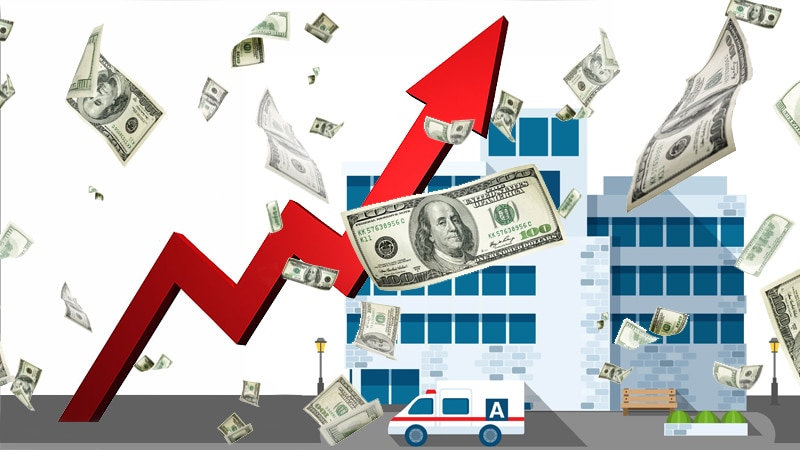Expert: Hospitals Waiting Out Labor Issues ‘A Failed Strategy’

While the pandemic has reduced admissions, hospitals and health systems across the US are facing higher costs for labor, drugs, and supplies, according to new research.
As COVID evolves, clinician supply has dwindled due to burnout and lack of availability, becoming a clear and present danger to the healthcare industry. Supply shortages have forced hospital systems into the repeated cycle of relying on contracting staffing firms to temporarily resolve staffing issues, becoming one of the largest driving forces of wage inflation.

Growth in labor expenses for hospitals and health systems are in large part due to the exorbitant rates charged by contract staffing firms. Staffing costs are now running up as high as 6% of labor expenses in hospitals and hospital systems, according to new research by healthcare provider research and comparative analytics collaborative Strata Decision Technology.
“This is a long-term cyclical problem. It takes a very short period of time for somebody to leave the profession. It takes a much longer time for somebody to get competitive and skilled as a nurse or doctor,” said Steve Lefar, chief strategy officer at Strata.
The research, conducted at 322 US hospitals, also indicates that, as expected, the pandemic has affected inpatient admissions and emergency department visits, which were well below 2019 levels. The report goes on to suggest that projecting out through 2022, this trend will likely continue, excluding patients with COVID and related testing and vaccinations.
“We saw a huge drop in patient demand at the beginning of the COVID-19 pandemic. Over time as hospitals and patients got more comfortable in this new phase, volume started to come back, but it has never hit those 2019, pre-COVID levels,” said Jennifer Ittner, senior director at Strata.
Inflation in healthcare systems has shown no signs of slowing down, and preparation has never been more important. Lefar warned that this won’t be an easy fix. Consequently, much focus and attention are required in order to combat this comprehensive problem. He proposed hospitals begin accounting for continual shocks to the market across all administrative margins, such as adjusting strategic plans and considering higher labor costs when producing short-term targets.
Additionally, Lefar encouraged administrative areas to monitor all spending unrelated to labor. Systems that are focused primarily on managing demand become vulnerable to losing current supply. Concentrating only on funding contract agencies prevents hospitals from investing those costs in their existing employees, leading to low morale and high turnover.
“The notion of waiting it out is going to be a failed strategy, because there just isn’t enough supply of the clinical staff that are needed to run the organization. … [T]here are a lot of issues in healthcare that have to be resolved, but if we don’t have clinicians it’s pretty tough to resolve them,” he said.
Drug and Supply Costs Also Rising
Ittner noted that while labor expenses have noticeably increased within the past 18 months, the pandemic has driven rising drug and supply costs as well.
“Other than labor supply, since the beginning of the pandemic the cost for institutions has been very high because supplies have been going up for a while, especially on things like [personal protective equipment],” she said.
Despite changes in volume during the pandemic, drug expenses per patient compared with pre-pandemic levels in 2019 saw significant increases. Strata found that cost inflation for drugs was 10%, and rose most at hospitals with fewer than 500 beds and for critical access and short-term acute care hospitals. Cost inflation for supplies was much lower at 3%, the research noted.
A study by GoodRx found that in January 2022 alone, drug companies increased the price of about 810 brand name and generic drugs that they reviewed by an average of 5.1%. Furthermore, the American Hospital Association found that by the end of 2021, total drug expenses were 28.2% higher than pre-pandemic levels.
Lefar and Ittner recommend layering in higher growth rates for labor and drug costs and using cost inflation estimates including and excluding median rates of COVID-19 cases.
The pair also placed overall emphasis on the need for healthcare facilities to acknowledge the possible effects of the issue at hand and do everything possible to prepare.
“How do we prepare and stay ready for the next pandemic, for the next shock? I’m not sure we’re ready for the next one … so how do we continue to manage what is happening now? By starting to think ahead,” said Ittner.
Frankie Rowland is an Atlanta-based freelance writer.
For more news, follow Medscape on Facebook, Twitter, Instagram, and YouTube.
Source: Read Full Article